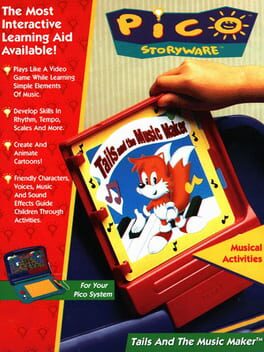Like Sonic the Hedgehog’s Gameworld, this is on an educational system based on the Mega Drive called the Pico.
Tails and the Music Maker isn’t so much a game you play from start to finish, but a collection of minigames and activities. The first page features a simple platformer game, across three short levels of a Green Hill Zone that turns more blue for each level. At the top of the screen are instructions for Tails to stop, tip-toe, jump or run. Tails will have to go slow to dodge coconuts and jump to make it over gaps (although if you fall, a spring will launch you back out. Also on this page is a simple game of musical chairs, played against frogs on lily pads.
Page 2 features a pinball game, where hitting instrument icons will cause the sound. Hitting the bell at the top seems to end the game. There’s also a minigame where you have to draw circles around notes. Page 3 features an extremely slow Arkanoid clone where you bounce tails around to break blocks of music.
Page 4 features a matching game. Click on an instrument and it will play the sound of another, click on the right one and they’ll vanish. This one doesn’t work well at all as the sounds don’t sound anything like each instrument, so instead you have to learn the tune played by each instrument. You can also play along (a few notes at a time) to a few nursery rhymes.
The final page features a simple drawing studio. You can click on colours on the book and draw whatever you choose, and add Sonic and Tails from the book as well. You can also visit a music studio and listen to the sounds of each instrument (the same as the ones from the previous game that don’t sound like the instrument) or to the nursery rhymes.
As an “edutainment” title, Tails and the Music Maker seems to be completely lacking on the “educational” side of things. The Pico seems like it’s aimed at slightly older children, whereas the functions of this game – at least the music-related ones – seem similar to most light up electronic keyboard toys that you can get for kids around the age of 1-2, and provide a more tactile feedback. And those ones usually have additional functions to teach colours, numbers and shapes.
Tails and the Music Maker isn’t so much a game you play from start to finish, but a collection of minigames and activities. The first page features a simple platformer game, across three short levels of a Green Hill Zone that turns more blue for each level. At the top of the screen are instructions for Tails to stop, tip-toe, jump or run. Tails will have to go slow to dodge coconuts and jump to make it over gaps (although if you fall, a spring will launch you back out. Also on this page is a simple game of musical chairs, played against frogs on lily pads.
Page 2 features a pinball game, where hitting instrument icons will cause the sound. Hitting the bell at the top seems to end the game. There’s also a minigame where you have to draw circles around notes. Page 3 features an extremely slow Arkanoid clone where you bounce tails around to break blocks of music.
Page 4 features a matching game. Click on an instrument and it will play the sound of another, click on the right one and they’ll vanish. This one doesn’t work well at all as the sounds don’t sound anything like each instrument, so instead you have to learn the tune played by each instrument. You can also play along (a few notes at a time) to a few nursery rhymes.
The final page features a simple drawing studio. You can click on colours on the book and draw whatever you choose, and add Sonic and Tails from the book as well. You can also visit a music studio and listen to the sounds of each instrument (the same as the ones from the previous game that don’t sound like the instrument) or to the nursery rhymes.
As an “edutainment” title, Tails and the Music Maker seems to be completely lacking on the “educational” side of things. The Pico seems like it’s aimed at slightly older children, whereas the functions of this game – at least the music-related ones – seem similar to most light up electronic keyboard toys that you can get for kids around the age of 1-2, and provide a more tactile feedback. And those ones usually have additional functions to teach colours, numbers and shapes.
